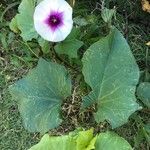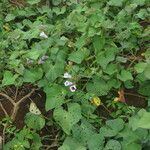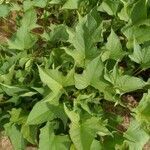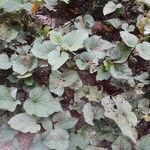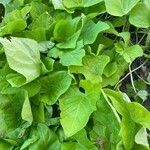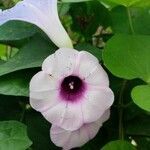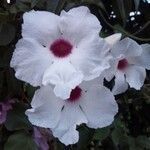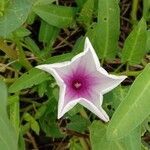Herbs annual, with ellipsoid, fusiform, or elongated subterranean tubers; sap milky; axial parts glabrous or pilose. Stems prostrate or ascending, rarely twining, green or purplish, much branched, rooting at nodes. Petiole 2.5-20 cm; leaf blade broadly ovate to circular, 4-13 X 3-13 cm, margin entire or palmately 3-5(-7)-lobed, herbaceous; lobes broadly ovate to linear-lanceolate, sparsely pilose or glabrous. Inflorescences 1-or 3-7-flowered; peduncle 2-10.5 cm, stout, angular; bracts early deciduous, lanceolate, 2-4 mm. Pedicel 2-10 mm. Sepals oblong or elliptic, ± unequal, glabrous or pilose abaxially, margin ciliate, apex acute, mucronulate, outer 2 sepals 7-10 mm, inner 3 sepals 8-11 mm. Corolla pink, white, pale purple to purple, with a darker center, campanulate to funnelform, 3-4 cm, glabrous. Stamens included. Pistil included; ovary pubescent or glabrous. Capsule rarely produced, ovoid or depressed globose. Seeds glabrous. 2n = 84, 90*.
Herb with underground, fusiform edible tubers.. Stems prostrate, ascending or rarely twining, often rooting at the nodes, glabrous or very slightly pubescent.. Leaf-blade triangular, 4–14 cm. long, 4–16 cm. wide, truncate or cordate at the base, entire or palmately shallowly to very deeply 3–5-lobed; lobes triangular to lanceolate, glabrous or slightly pubescent; petiole4–20 cm. long.. Inflorescences axillary; peduncle 3–18 cm. long, 1–several-flowered; pedicels 3–12 mm. long.. Sepals subequal, the inner somewhat longer, oblong to elliptic-oblong, 7–12 mm. long, 3–5 mm. wide, acute and distinctly mucronate, subcoriaceous.. Corolla violet or lilac, white above, campanulate, 3–4.7 cm. long.. Capsule ovoid.. Seeds glabrous.
Tuberous-rooted perennial. Stems trailing or erect, glabrous or hairy. Petioles long and slender, often > lamina. Lamina very variable in size, shape and dissection, particularly in the degree of lobing, usually entire with long-acuminate apices. Infl. an axillary cyme, usually few-flowered; peduncles to 8 cm long, stout; pedicels to 1 cm long. Bracts < sepals. Sepals c. 1 cm long, mucronate, glabrous; inner sepals slightly > outer. Corolla c. 4 cm long and 3-3.5 cm diam. across limb, funnelform, pink with purplish or reddish purple centre. Stamens included; filaments hairy towards base. Ovary surrounded by tuft of hairs. Capsule not seen.
Vines; stems usually somewhat succulent but sometimes slender and herba-ceous; perennial, glabrous or pubescent. Leaves variable, from cordate to ovate, entire, dentate or often deeply lobed, 5-10 cm long, glabrous or rarely pubescent. Flowers absent in some varieties, frequent in others, in few-flowered cymose inflorescences; sepals oblong, the outer sepals acuminate and cuspidate, (8-)10-15 mm long, mostly pubescent or ciliate; corolla with a lavender to purple-lavender limb and darker throat, white in some varieties, 4-7 cm long. Fruits uncommonly formed, ovoid, glabrous; seeds rotund, glabrous.
This is a root crop which produces long creeping vines. The leaves are carried singly along the vine. Leaves can vary considerably from divided like fingers on a hand to being entire and rounded or heart shaped. At the end of the vine, trumpet shaped flowers grow. They are purple. Under the ground fattened tubers are produced. There are a large number of varieties which vary in leaf shape and colour, tuber shape, colour, texture and in several other ways.
Leaf lamina triangular to broadly ovate in outline, 4–10×4–13 cm., entire or palmately shallowly to very deeply 3–7-lobed, truncate or cordate at the base; lobes triangular, lanceolate to linear-oblong, glabrous or slightly pubescent; petiole 3·5–15 cm. long, glabrous or hairy.
Sepals subequal, subcoriaceous, 7–10 mm. long; outer ones oblong or elliptic-oblong; inner ones elliptic-oblong or ovate oblong, somewhat longer, all glabrous or pilose on the back and fimbriate, acute or subacute, distinctly mucronate.
Inflorescence axillary, cymosely 1 to several-flowered; peduncle stout, 3–15 cm. long, glabrous or hairy, bracteoles minute, narrow, acute, 2–3 mm. long, early deciduous; pedicels 3–12 mm. long.
Stems prostrate, ascending or rarely twining, often rooting at the nodes, containing a milky juice, glabrous or very slightly pubescent.
Flowers campanulate-funnel-shaped with whitish or pink-tinged limb and red-purple centre 11/2-2 in. long.
Perennial plant herbaceous, with underground, fusiform to ellipsoid, yellow or reddish, edible tubers.
Corolla bell-shaped, pale-mauve, white above, 3–4·5 cm. long.
Trailing and climbing, nearly glabrous from tuberous root
Seeds glabrous.
Capsule ovoid.

